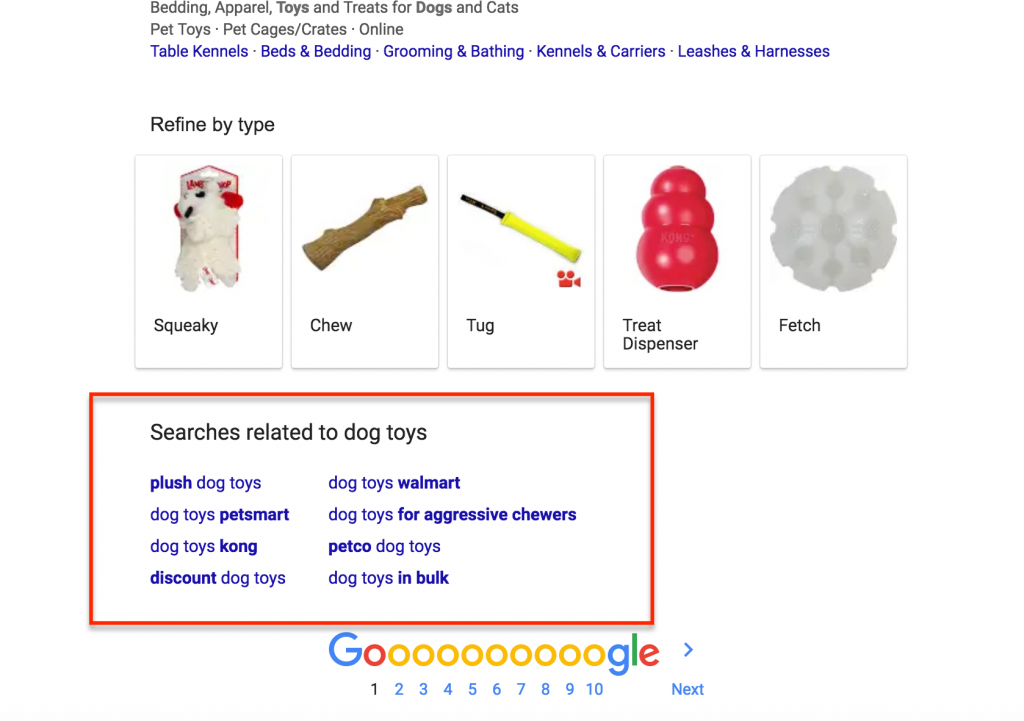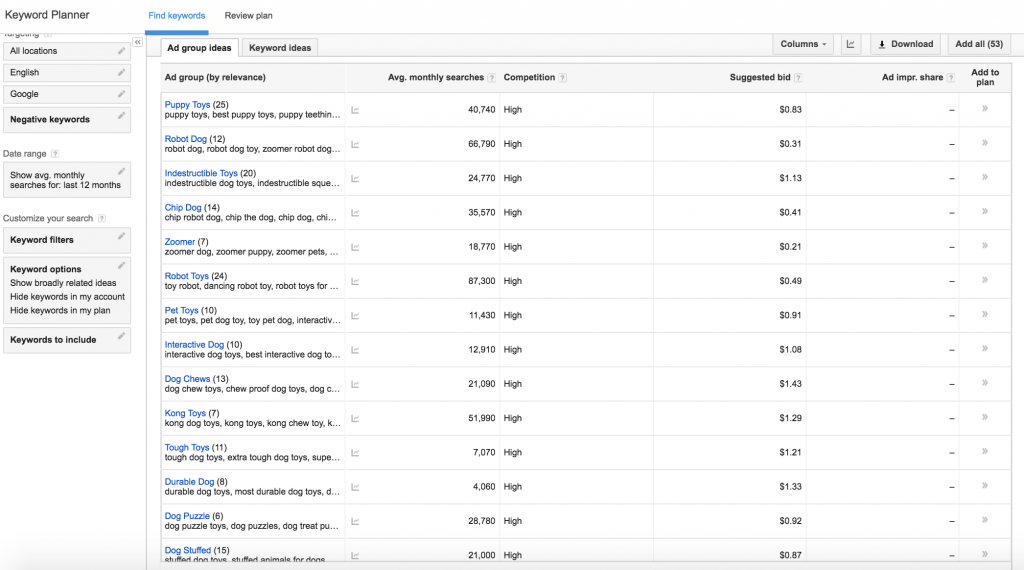Introduction to Google Keyword Planner, Part 3: The Keyword Research Process
In my last two posts, I provided a brief introduction to the Google Keyword Planner (GKP) and then showed you some of the more advanced features in the tool. For this third and final post in the series, I’m going to tie the whole thing together for you and show you an effective process for using the GKP to come up with keywords and content ideas that are sure to rank and draw in quality traffic.
Before that, though, a quick note: This process is far from being the only keyword research process, or even the best for that matter. But this process is a great way to acclimate yourself to keyword research and the GKP.

Finding Seed Keywords
As mentioned in the previous posts, you’ll need some seed keywords to get started. Think of seed keywords as the broad, top-level idea for the topic you want to focus on. In this instance, I’m going to start with “dog toy.”
But just “dog toy” may be a bit too broad, though. Google will likely see that and think I’m looking to buy a dog toy as opposed to research or write about them. So, I’m going to add the modifier “best” in front of it, which will help Google narrow the focus slightly. Some results for buying dog toys may come up, but so will some articles and other types of results as well.
With that settled, the first thing I’m going to do is type “best dog toy” into Google, but not hit enter. Instead, I’m going to let Google’s Auto Suggest present some ideas of similar searches other users have entered with my seed phrase.

Viewing these suggestions are a great way to test the waters and see what topics users are specifically searching for. You’ll want to copy down some or all of these as they’re a great place to start our search.
Once you jot those down, you can click “enter” for your seed phrase (“best dog toy”). Feel free to take a look at the results and maybe even copy a couple of the URLs down, as you can enter these into the “Landing Page” portion of the GKP later. But for now, our interest is in the “searches related to” section on the bottom of the page.

As with Auto Suggest, Google uses this area to share some of the related queries other people have searched for in the past. These two spots alone can be a gold mine for ideas, so make sure you copy these down. We’re about to see how valuable they are and what we can do with them.
Evaluating Keywords and Finding More of Them
Now it’s time to go to the GKP with our seed phrase and several related phrases that came out of it. We’ve already covered in the past two posts on how you can use these features to your advantage, so what I’d like to focus on here is how we can determine the best keywords along with finding more.
We’re going to start with the “Search for new keywords using a phrase, website, or category” section, and then enter our seeds into the “Your product or service” section. Because we’re still looking to cast a fairly wide net, we’re not going to use any of the filter features.
Enter in the phrases into the GKP and we’ll be taken to the now-familiar results page. Now, let’s take a closer look at each part of this page.

We’ve already discussed the Avg. Monthly Searches section, so let’s focus on some of the other pieces here, starting with the Search Volume Trends graph at the top. This section is meant as a graphical representation for how popular your searched seed phrase has been over the past year. This graph can be particularly helpful if you’re searching for a topic that has some sort of seasonality to it—for instance, typing in “Christmas dog toys” can give you an idea as to if more people are searching for this term in December, November, or even earlier. This feature is best used with one seed phrase at a time (as opposed to the list we dumped in there), so take the time to try this for particularly relevant seed phrases.
The next two sections highlighted above, “Competition” and “Suggested Bid” are two of the most important data points when deciding what keywords you really want to consider. While both of these refer to AdWords users, the data can still be quite helpful here too.
Competition is an indicator of how many people are trying to buy ads related to that keyword. So, if a keyword has a value of “High,” that means a lot of people are targeting it with their AdWords campaign—and if they’re targeting it with their paid ads, they are most likely targeting it with their organic search efforts as well.
Ideally, you want to focus on keywords that are searched often but have minimal competition. To do this, try picking out keywords that have the highest Avg. Monthly Search numbers and the lowest competition level.
Unfortunately, keywords with a high monthly search and a low competition level are about as common as unicorns, so you’ll likely find yourself left with a bunch of keywords with “High” competition values. This is when the “Suggested Bid” column comes in handy. This number is the estimated cost per click (CPC) advertisers are spending on each work. CPC is determined through a sort of bidding system built into AdWords and the Suggested Bid is an estimate pulled from that bidding data. In other words, the higher this amount, the more competitive it is. So, if you’re picking terms that have “High” competition numbers, then try to find the ones that have lower Suggested Bid amounts.
Using Ad Groups
There’s one more feature in the GKP that we’ve yet to cover: Ad group ideas. You’ll be able to access these by clicking on the “Ad group ideas” tab above your results.

Another tool created for paid search users but still helpful to everyone else, Ad Groups are collections of similar keywords that advertisers typically bid on at once. These are created from Google’s massive pools of data and organized as a way of streamlining the keyword research process for advertisers. The nice thing for us is that it contextually collects these words and recommends the ones that are most relevant to the seed phrases we entered.

In some ways, it takes some of the leg work out of our research process. In other ways, it offers up new keyword ideas that the other searches may not have. For instance, in the image above there is a whole group of keywords dedicated to “puppy toys,” something related to our seed phrase, but different enough to offer a host of new content ideas and keyword targets.
Wrapping It Up
You feel that? That’s the feeling of accomplishment you get once you’ve successfully completed your first keyword research project! By the time you’re finished the steps outlined in this series, you should have a wealth of keyword data to help inform your future content choices and organic search optimization efforts. As I mentioned earlier, this is barely scratching the surface of keyword research, but it’s a great start!
Michael Ferrari owns and operates Pen Cap Online Marketing, an agency specializing in search engine optimization. When he’s not helping businesses dominate the search rankings, he’s most likely hanging out with his wife, son, and beagle. You can reach him at “michael(at)pencapseo(dot)com”.
Image: ArthurStock/Shutterstock.com


